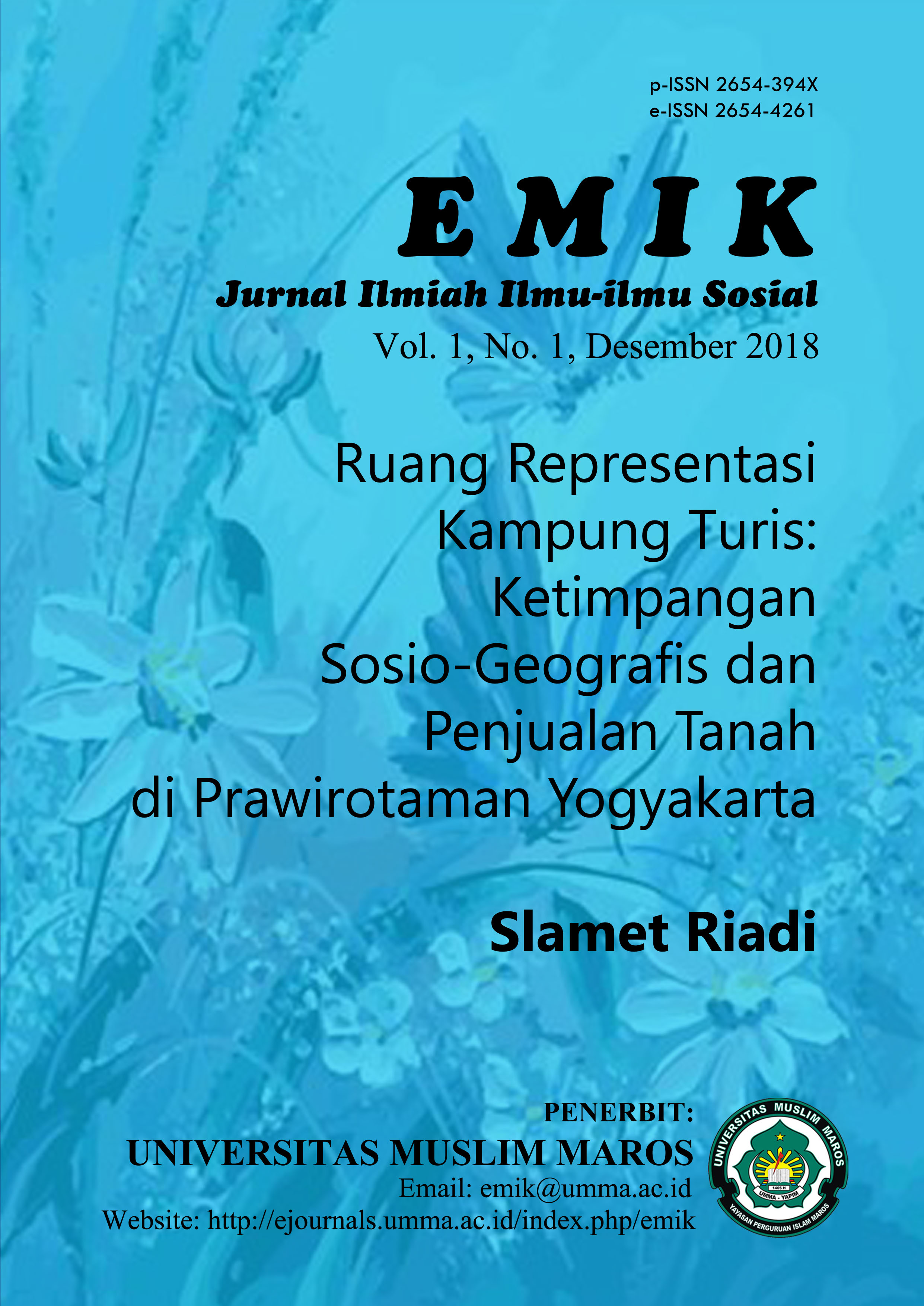Ruang Representasi Kampung Turis
Ketimpangan Sosio-Geografis dan Penjualan Tanah di Prawirotaman Yogyakarta
Keywords:
Spaces of Representation, Social Inqeuality, Uneven Development, Tourism AreaAbstract
Yogyakarta has become one of the main tourism destinies in Indonesia. There are so many policies which are being correlated to the development area. Tourism development in Yogyakarta has made some problems, especially about socio-economy aspect. Some of discourses to counter this conditionare arising in public space by some narrations like Jogja istimewa ketimpangannya, Jogja Ora Didol, Jogja Asat, and #GerakanMembunuhJogja. From historical point of view, Prawirotaman was a batik’s production area in 1960-1970s. Now, Prawirotaman has become one of tourism area in Yogyakarta. This study aims to understand how socio-economic transformations and how spatial production influences social relations in Prawirotaman.
The study was conducted in Prawirotaman in Mei 2018. Data was collected using in-depth interview, observation, and maps spatial analysis. The participants in this studt consit of entrepreneurs (hotel, travel, and batik celup) and informal workers (tricycle driver, parking attendans, bus driver, online driver, and stall seller) in Prawirotaman.
The research finding indicates: Firstly, some local people with their legacy and the new comer with their social relations can adapt with spatial transformation in Prawirotaman, then the others who are not have some legacy or social relations got enclosure from this development. Secondly, tourism expansion in Prawirotaman caused two types of inequality; social and uneven development.Two types of inequality in Prawirotaman come from spaces of representation as a kampung turis.In social side, local people in Prawirotaman had been enclosure to acces some jobs in hotels, because of there are many people sold their land to the new comer. Then, from uneven development side correlated to develop some infrastructures like road and lamp, where are only on tourism area in Prawirotaman. Thirdly, the spaces of representation make Prawirotaman become an abstract space, because has been to following capital and tourism industrial logic.
References
Cahyono, E. 2017. “Rambu-Rambu Pembangunan Kawasan Pedesaan: Pembelajaran Kasus Pengembangan Kawasan Pariwisata Nasional”, dalamZakaria, A (ed.), Potret politik dan Ekonomi Lokal di Indonesia: Dinamika Demokratisasi, Pengembangan Ekonomi, dan Kawasan Pedesaan. Yogyakarta: IRE, 375-413.
De Angelis, M. 2007. The Beginning of History: Value struggles and Global Capital. London: Pluto Press.
Elden, S. 2007. “There is a Politics of Space because Space is Political; Henri Lefebvre and the Production of Space”. Radical Philosophy Review, 10(2):101-116.
Hampton, M. 2003. “Entry Points for Local Tourism in Developing Countries: Evidence from Yogyakarta, Indonesia”. Jurnal Geografiska Annaler, 85(2):85-101.
Harvey, D. 2001. Spaces of Capital: Towards a Critical Geography. Edinburgh: Edinburgh University Press.
Harvey, D. 2003. The New Imperialism.New York: Oxford University Press.
Helbrecht, I. Schlüter, S. Mackrodt, U. Fullera, H. Ruppe, P. Genz, C. Walthalla, B. dan Dierksmeier, P. 2018. “Manufacturing Marginality: (Un-)governing the Night in Berlin”. Jurnal Geoforum, 94:24–32.
Lefebvre, H. 1991. The Production of Space. UK: Blackwell.
Lefebvre, H. 2009. “Space: Social Product and Use Value”, dalam Brenner, N dan Elden, S (eds), State, Space, World: Selected Essayss. Minneapolis: University of Minnesota Press, 185-196.
Macleod, D. 2010. “Power, Culture, and Production of Heritage”, dalam Macleod, D. and Carrier, J. (eds), Tourism, Power, and Culture: Anthropological Insights. UK: Channel View Publications, 64-90.
Marx, K dan Engels, F. 2010.Collected Works: 1845-1847. London: Electric Book.
Muallisin, I. 2007. “Model Pengembangan Pariwisata Berbasis Masyarakat di kota Yogyakarta”, Jurnal Penelitian BAPPEDA, 2:5-14.
Ness, S. 2005. “Tourism-Terrorism: The Landscaping of Consumption and the Darker Side of Place”. Jurnal American Ethnologist, 32(1): 118-140.
Piketty, T. 2014. Capital in the Twenty-first Century. USA: The Belknap Press of Harvard University Press.
Sesanti, D. A. 2016. Jogja-Ku (Dune Ora) Didol: Manunggaling Penguasa dan Pengusaha dalam Kebijakan Pembangunan Hotel di Yogyakarta. Sleman Yogyakarta: STPN Press.
Smith, N. 2008. Uneven Development: Nature, Capital, and the Production of Space. USA: The University of Georgia Press.
Sumintarsih dan Adrianto. 2014. Dinamika Kampung Kota Prawirotaman Dalam Perspektif Sejarah dan Budaya. Yogyakarta: Balai Pelestarian Nilai Budaya (BPNB) Daerah Istimewa Yogyakarta.
Warf, B. 2008. Time-Spaces Compression:HistoricalGeographies. USA dan Kanada: Routledge.










9.png)















